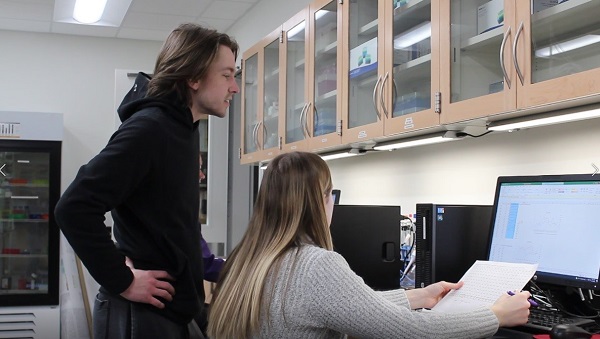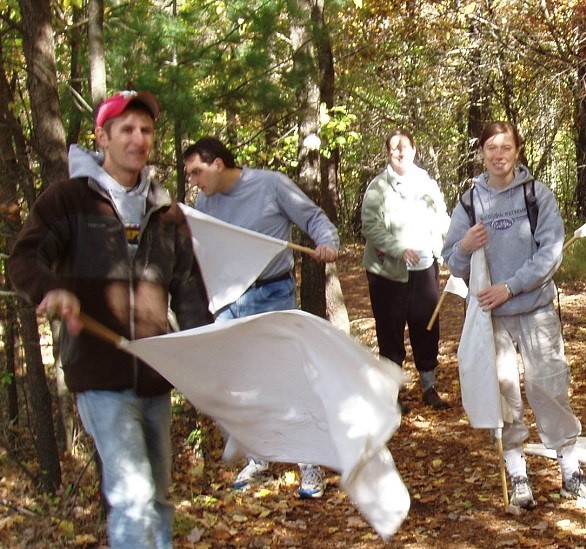From the University of Wisconsin, Stevens Point:
Diane Caporale has collected thousands of ticks during her career as a biology professor and researcher.
Since moving to Wisconsin 1999, she has had help. Nearly 500 students in her molecular biology courses at UW-Stevens Point have collected ticks each year from 2000-2020.
Tick surveillance is useful for predicting human disease risk. What’s especially significant about Caporale’s research is its duration.
This is the first continuous surveillance of tick-borne pathogens for two decades in the nation. “It’s been quite an enormous, exciting project,” she said.
“It was started in 2000 — before I was born — so it’s kind of crazy the amount of time this has been going on,” said Cody Korth, a student researcher in her lab.
Caporale first began collecting ticks in the Northeast, where she grew up.
When she was asked to develop a molecular biology course at UW-Stevens Point, it was an opportunity to broaden her research into tick-borne diseases. During the first week of October each year since 2000, her molecular biology students collect blacklegged ticks (Ixodes scapularis). It gives students the opportunity to use DNA as a tool to forecast the incidence of disease.
Three tick-borne pathogens
Blacklegged (or deer) ticks carry three pathogens that can cause human disease. Caporale’s students analyzed all three: Borrelia burgdorferi, the bacterium responsible for Lyme disease; Anaplasma phagocytophilum, a bacterium that causes Anaplasmosis; and Babesia microti, a protozoan that causes Babesiosis. The latter presents with malaria-like symptoms, while the others have flu-like symptoms.
Caporale and her students conducted research in what is known as a microgeographic region that is also convenient to campus: the Schmeeckle Reserve trail around Lake Joanis. They use white flannel flags to collect the ticks – a total of 2,008 in 21 years.
The students extracted DNA and analyzed it for the presence of three pathogens that cause human diseases, then sequenced the DNA to learn what percentage of ticks were infected with one, two or all three pathogens, said McKenzi Fernholz, who took molecular biology in 2019.

More prevalent over time
They found each pathogen became more prevalent over time. In 2000, Borrelia burgdorferi, which causes Lyme disease, was found in just the northwest segment of the trail. Seven years later, it reached detectable levels around the perimeter of the lake. The number of ticks with Borrelia peaked in 2015, which was also a year when a high number of ticks were infected with more than one pathogen.
Anaplasma was first detected in 2004 in the southeast segment. It reached detectable levels all around the lake within four years. Babesia was first detected in 2007 in the southwest region. It took eight years to reach detectable levels around the lake.
The highest number of infected ticks – 56% — was recorded in 2014.
An increase in the number of infected ticks in one year was related to an increase in tick-borne illness, notably Lyme disease, the following year, Korth said. The students compared their data with human disease statistics from Portage County and state public health units.
“If it’s increasing here, it’s increasing elsewhere,” said Caporale, who has also researched ticks in the Kettle Moraine area, Colfax and Whitewater. Overall, cases of Lyme disease oscillate, she said.
How rainfall affects tick population
Caporale’s students also monitored rainfall each June, average winter temperature in December through February and snow depth for conditions that favor ticks. More eggs hatched when rainfall was higher the prior year, and more snow increased the chance of winter survival, Caporale said.
Tick numbers around Lake Joanis dropped significantly in 2017. That summer, strong winds downed numerous trees on the north end of the trail. When trees were removed, so was refuge for white-footed mice, the main reservoir for these pathogens. Also, invasive buckthorn – a preferred vegetation for ticks – was removed or treated with herbicide. In fall 2021 no ticks were found along the lake trail where extensive restoration occurred. Students did find ticks around the Schmeeckle Reserve Visitor Center carrying Borrelia and Anaplasma.
As independent study researchers in Caporale’s lab, Fernholz and Korth analyzed all the sequenced DNA data collected over the 21 years and determined trends in tick infection rates. They developed graphs and charts to display the results and presented them at the College of Letters and Science research symposium earlier this month. The results will be submitted for publication this summer.
Predicting Lyme disease trends
It’s interesting to observe the correlation between infection rates in ticks and humans, Korth said, which means that tick surveillance may be able to predict Lyme disease trends in the following year.
“It’s worth the time to take the samples every year because when we compared our tick infection rates to the cases of Lyme disease in humans in Portage County, we saw a one-year difference consistently with pathogen emergence.”
Korth, a biochemistry major from Marshfield, enjoys doing research independently in the lab and said it’s helped him develop critical thinking and problem-solving skills outside of the classroom. “Research is why I came to UW-Stevens Point. I was pleased with how easy it was to get involved.”
Doing undergraduate research with Caporale helped Fernholz, of West Salem, realize she wants to pursue a career in research. “It allowed me to get a sense of what a career in molecular biology research would be like.” A biochemistry and Spanish major, she graduated in May.
Helping students learn research techniques and be inspired to pursue research careers is a proud legacy for Caporale, who will retire in August.
SOURCE OF PRESS RELEASE: University of Wisconsin, Stevens Point





















We invite you to comment on our Facebook page.
Visit LymeDisease.org Facebook Page